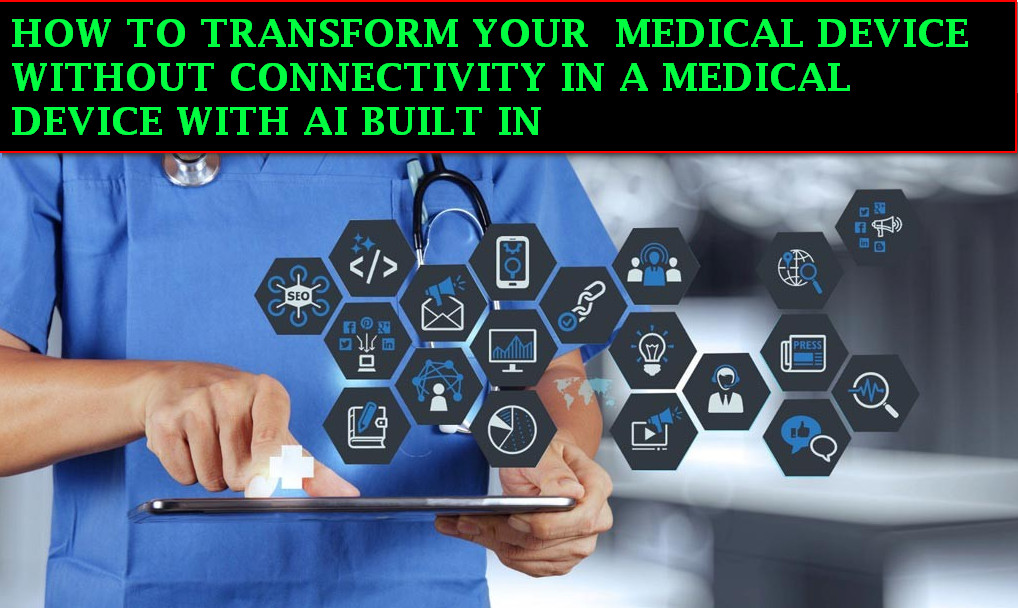HOW TO TRANSFORM YOUR MEDICAL DEVICE WITHOUT CONNECTIVITY IN A MEDICAL DEVICE WITH AI BUILT IN

HOW TO TRANSFORM YOUR MEDICAL DEVICE WITHOUT CONNECTIVITY IN A MEDICAL DEVICE WITH AI BUILT IN.jpg
1. HARDWARE ENHANCEMENTS
- Processing Power: You’ll need to integrate a more powerful processor capable of running complex AI algorithms. This could involve:
- Microcontrollers (MCUs) with AI accelerators: These are specifically designed for running AI at the edge.
- Embedded Systems: Small, specialized computers integrated into the device.
- Application-Specific Integrated Circuits (ASICs): Custom-designed chips optimized for your specific AI tasks.
- Memory: Increased memory (RAM) is necessary to store and process data used by the AI model.
- Storage: You’ll need storage (e.g., flash memory) to store the AI model itself and potentially store patient data for local processing.
2. AI MODEL OPTIMIZATION
- Model Selection: Choose AI models that are lightweight and efficient enough to run on the device’s limited resources. Consider techniques like:
- Model Quantization: Reducing the precision of model parameters to require less memory and processing power.
- Model Pruning: Removing unnecessary connections in the model to reduce its size and complexity.
- Knowledge Distillation: Training a smaller “student” model to mimic the behavior of a larger, more complex “teacher” model.
- On-device Training: Explore techniques to allow the model to adapt and improve its performance using data collected on the device itself (federated learning, transfer learning).
3. SOFTWARE DEVELOPMENT
- Embedded Software: Develop the necessary software to integrate the AI model into the device’s firmware and ensure real-time operation.
- Operating System: Choose a suitable operating system (e.g., real-time operating system) that can manage the device’s resources and support AI processing.
- Local Data Handling: Develop mechanisms for data acquisition, preprocessing, and storage on the device.
4. POWER MANAGEMENT
- Optimize for Efficiency: AI processing can be power-intensive. Implement strategies to minimize power consumption, especially if the device is battery-powered.
- Power Source: Consider the device’s power source and whether it can support the increased demands of on-device AI.
5. SAFETY AND RELIABILITY
- Real-time Performance: Ensure the AI model can process data and provide insights in real-time, especially for critical applications.
- Fault Tolerance: Implement mechanisms to handle potential errors or failures in the AI system to maintain device safety.
- Security: Protect the AI model and patient data from unauthorized access or tampering.
Example:
Consider a portable ECG monitor. To add built-in AI, you could:
- Integrate a powerful MCU: Choose an MCU with dedicated AI acceleration capabilities.
- Optimize an arrhythmia detection model: Select and optimize a lightweight AI model for detecting abnormal heart rhythms.
- Develop embedded software: Integrate the model into the monitor’s firmware to provide real-time alerts for potential arrhythmias.
Benefits of Built-in AI:
- Real-time operation: No need for network connectivity to get AI insights.
- Data privacy: Sensitive patient data can be processed locally, reducing privacy risks.
- Offline functionality: The device can function even without an internet connection.
Challenges of Built-in AI:
- Limited resources: Device size and power constraints can limit the complexity of AI models.
- Development complexity: Requires specialized expertise in embedded systems and AI.
- Cost: Adding more powerful hardware can increase the device’s cost.
By carefully considering these factors and overcoming the challenges, you can effectively integrate AI directly into your medical device.
